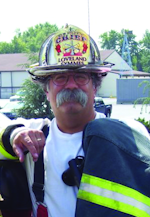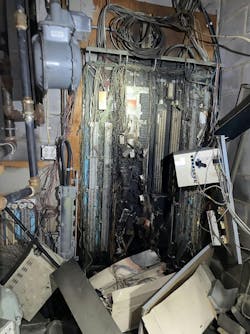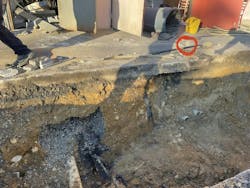Close Calls: ‘Minor’ Smoke Investigation Ends with an Explosion
I watch social media fire videos as an opportunity to learn. That said, as AI and other methods of video and photo alteration increase, I am cautious as to what I see, think and believe. Although some posts are very curious (Is this real? Was it edited?), some are very real, particularly when they are shared by the first-due department.
That was the case when a video was shared of when the Fairfax County, VA, Fire and Rescue Department (FCFRD) was dispatched for an outside fire-smoke from or near the sidewalk. Eventually, a firefighter was engulfed in fire. Fortunately, as a result of constant size-up and the members being protected with full PPE, the outcome was positive.
We all have seen firefighters who operate without full PPE—fully exposed, sometimes even with just a shirt and pants. They are careless, lackadaisical and undisciplined. That wasn’t the case on this run. The FCFRD firefighters were prepared and disciplined.
Why we have ‘full’ PPE
When I see clueless firefighters failing to wear all of their PPE when the need exists, I can’t help but remember FDNY’s “Watts Street Fire” heroes. Capt. John Drennan experienced horrific, third-degree burns to 65 percent of his body from a flashover at a multifamily dwelling fire. He fought hard to stay alive at the burn unit, but after 40 days of torturous struggling to survive skin grafts, organ failures and other problems, he could fight no more. He died at age 49. After his death, FDNY finally purchased and assigned full PPE “bunker gear” to its members. Drennan and Firefighters Christopher Siedenburg and James Young made the supreme sacrifice just wearing coats and rubber pull-up boots.
The reason that we have head-to-toe PPE and SCBA is because of what happened to firefighters (and victims) before we had the equipment. It’s 2024. Disciplined use of head-to-toe PPE with no exposed skin is the only way to operate.
My sincere thanks to FCFRD Assistant Fire Chief Dan Shaw and Firefighter Cory Kirby—who was engulfed in fire but was geared up properly (leading to no injury)—as well as Battalion Chief Dave Barlow and Lt. Nick Heufelder for their assistance.
Account from Heufelder
At 4:11 p.m., Engine 410 was dispatched for an outside fire with a report of “wispy white” smoke from a crack in the sidewalk near the Bravo side of a two-story, 350 x 100-foot, unsprinklered piggyback shopping center of Type II construction with mixed-use occupancies. E410 positioned itself on the A/B corner and investigated. (The single-company response is typical for an unknown hazard or an outside fire with no exposure risk to a structure.)
After identifying that it wasn’t Class A material or smoldering debris and that it appeared minor, we pulled our booster line but withheld flowing water—because of the minimal smoke smelling “electrical”—until the source could be identified and power could be controlled.
My first thought was that maybe it was burning trash in a drainpipe or a below-grade occupancy with an undetected fire, but there was no below-grade space and no drainpipes or sewer caps.
We obtained entry keys except for the communications closet that was adjacent to a parking lot, because the owner was unable to locate that key. An electrical closet that was next to the communications closet was the closest part of the building to the issue, and we wanted to determine the electrical service status and conditions in the room.
We found normal conditions for all of the first-floor occupancies, but power was down in the first-floor occupancies on the Alpha and Charlie sides. We used a 2-inch gap at the top of the wall that divided the electrical closet and the communications closet to look into the communications closet instead of forcing its door. (The incident remained isolated to the small hole in the sidewalk, and I felt no need to force entry yet.) By using four-gas meters and a TIC, we determined that there was no smoke, heat or gas issues. The businesses and second-floor occupancies were checked by my crew, because a bystander stated, “People live up there.” The power for the second-floor occupancies was out, too.
I walked by the transformer, thinking that maybe I would hear something that would indicate that it was the source, but nothing was found. (The power company was requested by the property manager earlier.)
It was hypothesized that we had smoke from an electrical event underground. It was unknown whether it still was active, but with no progression in smoke condition, it might have or might not have been “hot” still. E410 wasn’t equipped with electrical metering or detection devices.
With no change in conditions, at 4:21, I added a ladder company for more eyes on scene and because I normally don’t work the area. Truck 410 is more familiar with its first due, and its assigned shift captain was on the rig.
Smoke changes color
At 4:25, the smoke changed color and puffed but then returned to wispy white and then changed to dark gray. I requested a rescue squad for monitoring and its “hot stick” and another fireground channel to be ready for further escalation. There still were no signs of extension to the building.
I gave a situational report on the tactical channel. I knew that Barlow regularly monitors the channel, so my transmission would make him aware of the call and why was upgrading it.
With the assignment now matching a still alarm with one engine, one special service (rescue squad or truck/ladder company) and a battalion chief, I directed my crew to pull the 1.88-inch handline and be ready for deployment. The driver secured a water supply, and everyone except the driver donned SCBA.
Moments later, conditions worsened, but the cause still was unidentified. The firefighter on the nozzle and I felt movement through the pavement under our feet when smoke puffed. T410 was about a block away, so I held off on expediting utilities until I consulted with the captain: I thought that, with all of the power being controlled to the building and without evidence of a gas leak, it was worth taking a moment to confer with the normally assigned crew about the possibility of isolating the event to a known cause.
T410 arrived, and, almost simultaneously, the smoke stopped. However, 20 seconds later, smoke appeared at the top of the electrical closet.
‘That smoke looks gross’
With smoke coming out from the open electrical closet door, I got low under the smoke to see whether anything was burning. The origin was from the communications closet, with an unknown route of extension to the building. I further upgraded to a full commercial structure fire box alarm response at 4:27.
I directed the two firefighters who were on the engine with me to get the line charged and in position, to mask up on air because “that smoke looks gross” and to force the door of the communications closet. I told the nozzle firefighter that if she saw any indication of charged electrical appliances or evidence of live current to withhold water until I returned. I ran to the Charlie side and ensured that the evacuation was done and then travelled back to my crew. I scanned the communications closet door with the TIC, which showed normal conditions and no heat signature. I proceeded to the Alpha side and evacuated the immediate exposure. I then transmitted my situational report, that all occupants were confirmed to be out of the structure.
An explosion
At 4:29, I rounded the corner from the Alpha side to the Bravo and stopped 25–30 feet away from the two closets. While transmitting, I saw my nozzle firefighter, who was positioned 20 feet back and to the left of the communications closet door (a safe distance because of the possibility of an electrical fire), bleed the line. Kirby began to force open the communications closet door. With the door open fully to give the nozzle firefighter the best view inside of the 4 x 6-foot space, Kirby walked toward me, and a moment later, he was enveloped in a flash fire and a dust cloud.
After the explosion, I held my mic open to control the channel while I checked to see whether Kirby was OK. I made eye contact with him as he seemed to be doing a personal inventory. I gave an inquisitive thumbs up, and he indicated he was fine. The nozzle firefighter was upright and showed no signs of injury, and I saw no need to call a mayday. I lost my place in my situational report and advised Barlow to stand by, giving myself a second to confirm my crew’s status. I then reported that all members were “OK” and requested utilities to be expedited.
I followed Barlow’s directions to maintain a defensive posture until units arrived at my location.
Later, I spoke with Kirby. Before the explosion, he knew that the problem was behind the locked communications closet door and that we needed to gain access. He was comfortable forcing it by himself. After masking up and assessing the door, he gained access. He stated, “I peeked in quick and didn’t see anything crazy or indications of a rapid event, but because of what they tell you in training that you never want to stand in front of the opening, I moved to the side.” Of the explosion, he said, “It happened so fast I didn’t really know what it was.” Both firefighters and I noted the percussion of the explosion but didn’t feel like it was very powerful.
The power company arrived and isolated the source of the power at the transformers. The photographs from that night and the morning after showed the locations of the crossed electrical service lines and the burn path that the energy took to the communications conduit leading to the communications closet. Once the heat made it to the conduit, it had a direct path to the communications closet. Using the TIC, it was noted that the ground in the area was warmer (20–30 degrees Fahrenheit) than that around it but not significantly noticeable on the surface.
Account from Kirby
I was instructed to force open the door of the communications closet to verify contents and condition. Before approaching the door, I verified that all of my PPE was donned and that I was on air. As I approached, I noted that the door was an outward swinging, right-handed, metal door/metal frame. We had a line charged and at the ready, if needed.
The closet showed no signs of a potential rapid-fire event. I opened the door slowly. The smoke was approximately halfway down to the floor and not pressurized. I opened the door completely, ensuring to step out of the threshold. As I opened the door, I heard a loud boom and felt a wave of pressure.
After realizing what happened but not to what extent, I advised my lieutenant that I was OK and continued my tasks. After extinguishment of some fire in the corner of the closet, I saw the extent of the damage. The wall and roof were blown off, the windows of the adjacent building were shattered, and my unit identifier was found across the parking lot.
Account from Barlow
This area of Fairfax County lies on the border of both the city of Alexandria and Arlington County, resulting in a multijurisdictional automatic-aid response. Because the incident was upgraded and of inherent delays with mutual-aid resource deployment, I was responding and monitoring the tactical radio channel prior to the first-due mutual-aid battalion chief being dispatched to the scene.
Prior to Heufelder completing his updated conditions report, a large explosion was heard on the radio. Heufelder calmly indicated that there was an explosion and advised me to stand by. He reported that all members were OK and requested the utility company.
I requested a RIT taskforce (one engine, one truck, one medic unit and one battalion chief) and ordered Heufelder to implement a defensive strategy until additional resources arrived that was based on the lack of on-scene resources, the unknown nature of the event, the sudden change in conditions (the explosion) and the complexity of the structure. The area of Fairfax County where the incident occurred is known for having significant issues with the power grid.
The mutual-aid battalion chief arrived as the closest command officer, established command and transitioned into an offensive strategy. Further investigation revealed that the incident was confined to the communications closet. With no life hazard or a fire in the units, we monitored the situation until the power company arrived to control power. Once power was disconnected, units completed normal fireground assignments, checking for extension and completing overhaul operations.
Comments by Goldfeder
The FCFRD sized up—a real size-up, where they got out of the rig and checked every possible area where there could be a problem. We all have seen headlines where firefighters didn’t even get out of the apparatus and assumed everything was fine—until it wasn’t.
The company officer who was on scene didn’t like what he saw, so he called for additional resources, just in case.
The FCFRD members geared up fully with full PPE and SCBA, just in case.
The battalion chief heard what was going on and ordered additional companies, just in case.
That is what training and discipline create: proactive leadership and actions.
People call us for a reason, and we can’t leave until we exhaust every possibility for that call. See nothing? Look harder. Call the caller back. Have that person meet you and show you why the call was made. Sometimes, the reason for a call is very obvious when we pull up, but other times it isn’t, and that’s when we can get in trouble.
In memoriam
We mourn the loss on Feb. 16, 2024, of Loudoun County, VA, Combined Fire and Rescue Volunteer Firefighter Trevor Brown of Sterling who was killed in the line of duty. Members responded to a report of a gas leak. While the crew worked to determine the problem, an explosion took Brown’s life and injured other members. Brown and all who were on scene were doing what any firefighter would do: helping the public solve a problem in a well-trained and disciplined manner. Rest in peace, brother.

Billy Goldfeder
BILLY GOLDFEDER, EFO, who is a Firehouse contributing editor, has been a firefighter since 1973 and a chief officer since 1982. He is deputy fire chief of the Loveland-Symmes Fire Department in Ohio, which is an ISO Class 1, CPSE and CAAS-accredited department. Goldfeder has served on numerous NFPA and International Association of Fire Chiefs (IAFC) committees. He is on the board of directors of the IAFC Safety, Health and Survival Section and the National Fallen Firefighters Foundation.








